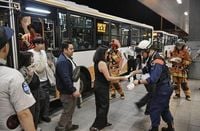Passengers aboard United Airlines Flight UA32 experienced a harrowing ordeal on September 12, 2025, when their Boeing 737-800 was forced to make an emergency landing at Kansai International Airport in Japan. The flight, which had departed Tokyo Narita Airport at approximately 5:40 PM local time, was en route to Cebu, Philippines, carrying 135 passengers and 7 crew members. About 50 minutes into the journey, a cockpit warning light indicated a potential fire in the plane’s cargo hold, prompting the crew to divert the aircraft and initiate emergency procedures, according to Newsweek.
The drama unfolded quickly. As the cockpit alert sounded, the pilots made the decision to reroute to Kansai International Airport, a major hub serving the cities of Osaka, Kyoto, and Kobe. The aircraft landed safely at around 7 PM local time. United Airlines confirmed that the landing was precautionary, with the safety of passengers and crew as the top priority. The airline stated, “Upon initial inspection by maintenance, there is no indication a fire occurred.”
Once the plane was on the tarmac, the crew wasted no time. All passengers and crew were instructed to evacuate the aircraft using emergency escape slides. The evacuation, described by one passenger as taking about five minutes, was swift but not without incident. Two passengers sustained minor injuries during the evacuation process and were transported to local hospitals for treatment. United Airlines later reported, “The aircraft landed safely, and passengers deplaned via slides. Customers have been bused to the terminal.”
Japanese broadcaster NHK captured the anxiety of the moment through the words of a passenger in his 40s, who recounted his experience. He said, “I was a little unsettled, wondering what the reason was, but there was no sign of confusion.” However, the calm didn’t last. “After the emergency landing, we were instructed to evacuate, which made me panic. It took about 5 minutes to evacuate,” he recalled. His remarks, originally given in Japanese, highlighted the tension that can arise even when procedures are followed to the letter.
The incident had immediate ripple effects at Kansai International Airport. Both runways were temporarily closed to allow for thorough safety checks and to ensure that the incident did not pose any further risk to ongoing operations. This closure led to brief disruptions of other flights, but airport authorities managed to reopen one runway shortly afterward, allowing partial operations to resume. The swift response from airport staff underscored the importance of rigorous safety protocols in modern aviation.
United Airlines’ quick response and the professionalism of the crew were widely praised. The fact that the evacuation was completed in about five minutes, with only minor injuries reported, speaks to the effectiveness of safety training and preparedness. The airline’s decision to err on the side of caution, despite an initial inspection revealing no evidence of an actual fire, reflects a broader industry trend of prioritizing passenger safety above all else.
While aviation emergencies remain rare, they are never far from the public consciousness. The United Airlines incident comes on the heels of another high-profile event in October, when a Turkish Airlines flight from Seattle to Istanbul was forced to divert to New York after the pilot collapsed and died mid-flight. Captain Ilcehin Pehlivan, 59, had undergone a routine health check in March that showed no medical problems, according to Turkish Airlines spokesperson Yahya Üstün. Despite immediate first aid efforts, Pehlivan could not be revived. Üstün later expressed the airline’s condolences, stating, “As Turkish Airlines, we deeply feel the loss of our captain and extend our sincerest condolences to his bereaved family, colleagues, and all his loved ones.”
These incidents, though uncommon, serve as stark reminders of the unpredictable nature of air travel and the critical importance of emergency preparedness. The aviation industry is built on layers of safety protocols, from rigorous maintenance checks to comprehensive crew training. In the case of United Airlines Flight UA32, the cockpit warning system did its job—alerting the crew to a potential hazard and prompting decisive action. Even though the initial inspection found no sign of fire, the precautionary measures taken ensured that all passengers and crew were brought to safety.
For passengers, the experience was undoubtedly unsettling. Emergency evacuations are rare, and the sight of escape slides deploying on a commercial airliner is enough to shake even the most seasoned traveler. Yet the orderly conduct during the evacuation, as described by passengers and confirmed by United Airlines, is a testament to the effectiveness of pre-flight safety briefings and the professionalism of airline staff. As one passenger noted, initial uncertainty gave way to panic only after the evacuation order was given, highlighting the psychological toll such incidents can take even when managed well.
The temporary closure of both runways at Kansai International Airport was a necessary step, reflecting the seriousness with which aviation authorities treat potential emergencies. The brief disruption to other flights was a small price to pay for ensuring the safety of everyone involved. Once safety checks were completed and one runway reopened, normal operations resumed, minimizing the broader impact on travelers and airport staff.
United Airlines’ transparent communication throughout the ordeal was crucial in managing both passenger concerns and public perception. By providing timely updates and confirming that no fire was found upon inspection, the airline helped to reassure passengers and the public that all necessary precautions had been taken. The swift transport of injured passengers to local hospitals and the provision of buses to take passengers from the aircraft to the terminal further demonstrated the airline’s commitment to passenger care.
Looking at the broader picture, incidents like the one involving Flight UA32 are reminders of the inherent complexities of air travel. Modern aircraft are equipped with advanced safety systems designed to detect even the slightest anomalies, and crews are trained to respond to a wide range of scenarios. While false alarms can be disruptive, they are preferable to the alternative of missing a genuine emergency. The events of September 12, 2025, at Kansai International Airport illustrate the delicate balance between caution and disruption that airlines and airports must navigate every day.
As travelers continue to crisscross the globe, the lessons from United Airlines Flight UA32 will no doubt inform ongoing efforts to enhance aviation safety. For the passengers and crew involved, the experience was a vivid reminder of the professionalism and preparedness that underpin every successful flight, even when the unexpected occurs.


